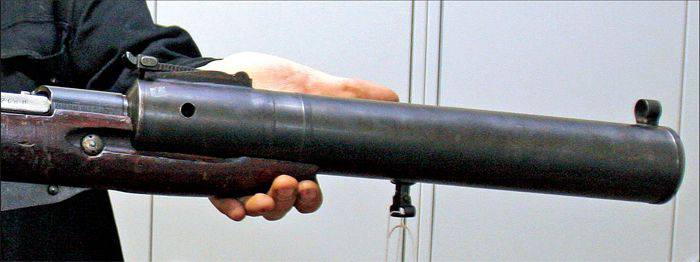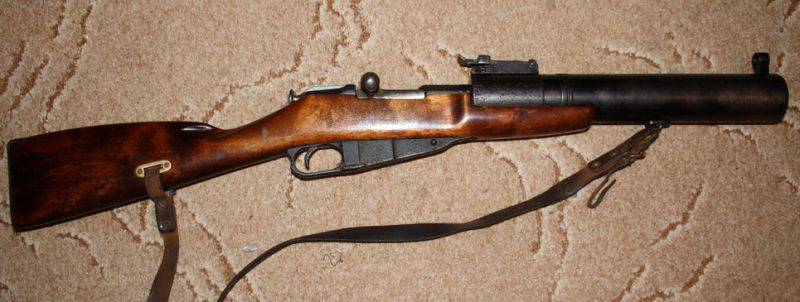Manual Nayman PMN-50 mortar
For various reasons, precise and detailed information about the PMN-50 project is missing. There are some plausible assumptions about its origin, in addition, a number of samples of these weapons have been preserved. However, much of the information of interest remains unknown. However, even in the conditions of such a lack of information, this curious weapon can be considered, which is of great interest from the point of view stories and technology.
According to the available data, the PMN-50 product was developed by the special technological bureau of the Scientific Research Institute-6 of the People's Commissariat of Ammunition, and the design work was supervised by I.M. Naiman. Thus, the name of the development stands for "Nayman's hand mortar, caliber 50 mm." The reasons for the appearance of the project, in turn, are unknown. On this account, you can only speculate.
Apparently, the appearance of the mortar PMN-50 led to an analysis of the capabilities and prospects of existing systems. The existing rifle mortars made it possible to throw light fragmentation ammunition at the enemy, but they limited the use of basic rifles and also increased their weight. More serious artillery systems, such as 50-mm company-made mortars of the 1938 and 1940 types, were notable for their heavy weight and relatively low mobility. Probably, the specialists of SRI-6 decided to combine rifles with rifle grenades and mortars, which led to the formation of the appearance of the original weapon.
As a basis for the mortar PMN-50 were taken Mosin serial rifle arr. 1891 / 30 and available 50-mm mortar 1938 / 40. The rifle was supposed to give a new weapon a part of the box, a receiver, ammunition mechanisms, a bolt and a part of the barrel. From the mortar it was proposed to take the barrel without rifling. In addition, the new weapon should have used exactly 50-mm mines.
The surviving samples of Naiman’s hand-held mortars have some technical and technological differences, but the overall architecture of these products is the same. Serial rifles with various damage to the barrels, excluding their further use, were taken as the basis for the mortar. Most of the barrel, with the exception of the chamber and a small section of the breech, was removed. In addition, the bed was trimmed, and in the remaining part of it a notch of larger diameter was made. Next to the trimmed barrel rifle attached mortar barrel. The mortar barrel and the bed are usually not fastened together.
In connection with the radical alteration of the “native” rifle barrel, the sights were transferred to the mortar barrel. A standard open sight was mounted in its breech, and a fly was attached to the barrel. In order to simplify production, the PMN-50 installed sights that were removed from the base rifle. This led to a reduction in the sighting line, and also required the use of new methods of aiming.
Together with a manual mortar, fragmentation mines of caliber 50 mm, which were already used with mortars, were to be used. 1938 / 40 Products 0-822 and 0-822А had a weight of 0,86 and 0,922 kg, respectively, received a steel or cast-iron body and carried an explosive substance on 90 g. The differences between the mines consisted in the material of the hull and the design of the tail stabilizer: the 0-822 was six-pointed, the 0-822А - four-pointed. When used with a hand mortar, mines were not equipped with their own propelling charge. According to some information, similar ammunition of a different purpose could be used with a mortar, which was connected with the supply of such weapons to special units. Thanks to these products, the fighters could not only destroy the enemy's manpower, but also solve other tasks, such as setting smoke screens, etc.
In order to reduce the recoil momentum when firing, PMH-50 had to use mines without their own propelling charges. Instead, it was proposed to use idle rifle cartridges with a lower charge. Naturally, this reduced the maximum firing range, but allowed to fire without using the base plate and other "traditional" mortar units, while holding the weapon with your hands.

Barrel borrowed from mortar
As follows from the available data, firing from a PMN-50 manual mortar was supposed to look like this. Having taken a position, the mortar gunner (or mortar gunners) had to charge the rifle with a blank cartridge and then place the 50-mm mine in the barrel. After that, it was necessary to rest the weapon with the butt into the ground and proceed to targeting. With the help of the existing sight, it was proposed to point the weapon in the right direction and hold it with the required angle of elevation. Then, using a standard firing mechanism, a shot was fired, and the powder gases of the idle cartridge pushed the mine out of the barrel.
The exact characteristics of PMN-50 are unknown, but some assumptions can be made. So, with the raised frame of the standard sight, there was a possibility of firing with angles of elevation no more than 12-15 °. Given the relatively small propellant charge, the range of the mines could hardly exceed 150-200 m. The maximum range at the optimum angle, in turn, could not exceed 300-400 m.
The existing RMN-50 specimens show attachments for bipods that were not removed from the mortar barrel during assembly. Thus, in theory, a manual mortar could retain the ability to use bipods and shooting from the stop. It is not known whether this method of using weapons was used, but this possibility cannot be ruled out.
As already mentioned, Nayman’s hand-held mortars were made from Mosin’s serial rifles of various modifications with various barrel damage. The continued use of this weapon for its intended purpose was not possible, which is why it was converted into mortars by removing damaged parts. The origin of the mortar trunks is unclear, but, apparently, new aggregates of relatively simple design were used.
In the available sources it is mentioned that the RMN-50 systems were in service with special groups of the NKVD, which performed various tasks in the rear of the enemy. This fact is also related to the use of not only fragmentation, but also other mines with special equipment. For obvious reasons, the details of the use of such weapons remain unknown.
Manual mortars based on existing weapons were produced in series and delivered to the customer in the person of the People's Commissariat of Internal Affairs. In addition, deliveries to the Red Army units are not excluded. It is known that several RMN-50 samples, which are now museum pieces, have survived to this day. It is noteworthy that, despite the presence of several surviving mortars, information about this development is extremely scarce.
The manual mortar of Nayman RMN-50 is one of the most interesting models of Russian weapons of the Great Patriotic War. However, the story has not retained most of the information about this development, or they have not yet been discovered. And yet, despite the small fame, these weapons in one way or another approximated the victory over the enemy, and therefore worthy of mention.
On the materials of the sites:
http://tv.sb.by/
http://forum.guns.ru/
http://strangernn.livejournal.com/



Information